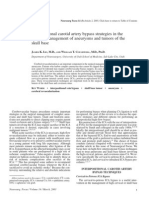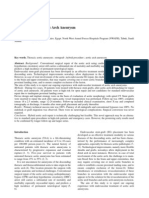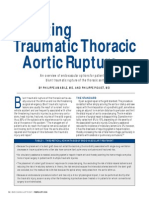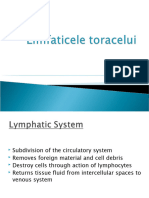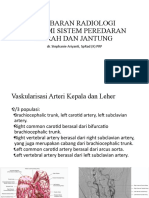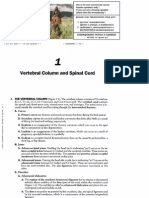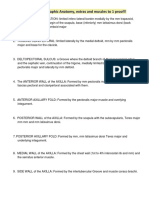Treatment of Aortic Arch Aneurysms Open Surgery or Hybrid Procedure
Treatment of Aortic Arch Aneurysms Open Surgery or Hybrid Procedure
Uploaded by
Jonathan Frimpong AnsahCopyright:
Available Formats
Treatment of Aortic Arch Aneurysms Open Surgery or Hybrid Procedure
Treatment of Aortic Arch Aneurysms Open Surgery or Hybrid Procedure
Uploaded by
Jonathan Frimpong AnsahOriginal Title
Copyright
Available Formats
Share this document
Did you find this document useful?
Is this content inappropriate?
Copyright:
Available Formats
Treatment of Aortic Arch Aneurysms Open Surgery or Hybrid Procedure
Treatment of Aortic Arch Aneurysms Open Surgery or Hybrid Procedure
Uploaded by
Jonathan Frimpong AnsahCopyright:
Available Formats
ADULT: AORTA: SURGICAL TECHNIQUES
A hybrid aortic re-arching technique
Fuyuki Hirashima, MD,a,b Marek Polomsky, MD,a,b Willie Dong, BS,b Jennifer L. Risi, BS,b and
Chris K. Rokkas, MD,a Burlington, Vt
From the aUniversity of Vermont Medical Center, and bLarner College of Medicine, University of Vermont, Bur-
lington, Vt.
Read at the American Association for Thoracic Surgery Aortic Symposium Workshop, Boston, Massachusetts,
May 13-14, 2022.
Disclosures: The authors reported no conflicts of interest.
The Journal policy requires editors and reviewers to disclose conflicts of interest and to decline handling or re-
viewing manuscripts for which they may have a conflict of interest. The editors and reviewers of this article
have no conflicts of interest.
The current affiliation of Dr Rokkas is University of Wisconsin School of Medicine and Public Health, University
of Wisconsin - Madison, Madison, Wis.
Received for publication June 2, 2022; revisions received July 26, 2022; accepted for publication July 29, 2022;
available ahead of print Aug 6, 2022.
Address for reprints: Chris K. Rokkas, MD, University of Vermont Medical Center, H4/344A CSC, 600 Highland Re-arching technique: Bypass grafts to the aortic
Ave, Madison, WI 53792 (E-mail: ckrokkas@yahoo.com). arch branches.
JTCVS Techniques 2022;15:18-21
2666-2507
CENTRAL MESSAGE
Copyright Ó 2022 The Author(s). Published by Elsevier Inc. on behalf of The American Association for Thoracic
Surgery. This is an open access article under the CC BY-NC-ND license (http://creativecommons.org/licenses/by- The re-arching technique in-
nc-nd/4.0/).
https://doi.org/10.1016/j.xjtc.2022.07.021 cludes a first stage of construct-
ing bypass grafts to the arch
Hybrid repair of aortic arch aneurysms involves technically branches by utilizing bilateral
challenging de-branching procedures requiring construc-
tion of graft anastomoses to the left subclavian and innom- axillary artery cut-downs, and a
inate arteries. Exposure of the intrathoracic segment of the second stage of endovascular
aortic arch branches may be difficult, particularly that of the completion.
left subclavian artery, frequently requiring a left carotid to
subclavian artery bypass before the de-branching proced-
ure.1 We present a simplified method of aortic arch revascu-
larization, termed re-arching, where the bypass grafts are
tunneled from the ascending aorta to the axillary arteries
compression and crowding of the graft. The 8-mm graft off the ascending
bilaterally. A subsequent thoracic endovascular aortic repair aorta was anastomosed to the proximal left common carotid artery in an
(TEVAR) of the aortic arch aneurysm is performed. This end-to-side fashion (anastomosis A), and the origin of the left common ca-
method precludes the need for a carotid to subclavian artery rotid artery was ligated. The patient was then weaned off CPB. Next, the
bypass before TEVAR. 10-mm branch off the ascending aorta was tunneled to the left infraclavic-
ular space through the second intercostal space, and it was anastomosed to
the left axillary artery in an end-to-side fashion (anastomosis B). The sec-
METHODS ond intercostal space is mostly a fixed area not prone to kinking. Tunneling
The patient reported on herein provided informed written consent for is performed with a long curved blunt clamp in a direction from the left in-
the publication of study data. As an individual case report with no identifi- fraclavicular area towards the anterior mediastinum under direct visualiza-
able patient information, our institutional review board deemed publication tion. An adequate opening is created within the intercostal space to provide
of the study exempt from approval. comfortable passage of the graft. The 10-mm graft to the right axillary ar-
A 58 year-old woman presented with an asymptomatic aneurysm of the tery that had been previously used as an arterial inflow conduit was
distal aortic arch associated with a penetrating atherosclerotic ulcer tunneled into the mediastinum through the right second intercostal space.
(Figure 1). Due to multiple comorbidities and extensive atherosclerosis Tunneling is performed in a direction from the posterior chest wall to the
of the aortic arch, she would have been a high-risk patient for an open right infraclavicular area. The graft was then anastomosed to the 10-mm
anatomic reconstruction under circulatory arrest. Bilateral axillary artery graft supplying the left axillary artery in an end-to-side configuration (anas-
cut-downs were performed. A 10-mm graft was anastomosed to the right tomosis C). The innominate artery was ligated at its origin. The patient
axillary artery, following administration of 3000 U heparin intravenously. returned 4 weeks later to undergo a TEVAR procedure with a
A median sternotomy was then performed and cardiopulmonary bypass 32 3 28 3 178-mm endograft deployed to zone 0. Angiography showed
(CPB) was instituted via the right axillary artery and right atrium with no type 2 endoleak, therefore endovascular occlusion (plug) of the left sub-
the patient being fully heparinized. A multibranch aortic arch graft was clavian was not required (Figure 3).
used (Plexus; Terumo Aortic), and a patch including the origins of the
10-mm and 8-mm grafts was tailored from this graft (Figure 2 and
Figure E1). This patch was anastomosed to the anterolateral aspect of the RESULTS
ascending aorta during a short period of cardioplegic arrest. It is important Bilateral radial arterial monitoring showed equal and
to avoid anastomosis to the anterior wall of the ascending aorta to prevent appropriate systemic blood pressures. Follow-up computed
18 JTCVS Techniques c October 2022
Adult: Aorta: Surgical Techniques
FIGURE 1. Aneurysm of the distal aortic arch associated with a penetrating atherosclerotic ulcer (arrows).
tomography angiogram showed no evidence of endoleak; a patient’s aorta. We believed that the application of a partial
completely thrombosed aneurysm sac; and patent grafts occlusion clamp on the ascending aorta would not have
supplying the right axillary, left axillary, and left common been entirely safe. In other de-branching cases, we have per-
carotid arteries (Figure 3). formed the aortic anastomosis without the use of CPB.5 For
the proximal aortic anastomoses, a bifurcating graft or even
2 separate grafts can be used. By using the multibranch
DISCUSSION
graft, the branches are optimally oriented without protrud-
We believe that low-risk patients who require extensive
ing through the side of the aorta. The remaining graft mate-
replacement of the aortic arch should still have an anatomic
rial is also used in the reconstruction.
repair. However, a hybrid approach is preferred to anatomic
reconstruction in high risk patients.2,3 This staged proced-
ure frequently requires the additional step of a left carotid CONCLUSIONS
to subclavian artery bypass or a subclavian artery transposi- Our novel hybrid re-arching approach of aortic arch recon-
tion to revascularize the hard-to-reach left subclavian ar- struction simplifies the standard de-branching technique by
tery.4 This is often necessary even when the de-branching avoiding the technically challenging intrathoracic anastomo-
operation is performed on CPB. ses to the innominate and the left subclavian arteries. In addi-
For our patient, we used CPB and a brief period of cardi- tion, the anastomosis to the left axillary artery eliminates any
oplegic arrest to safely perform the anastomosis of the patch
graft island to the aorta, given the relatively small size of the
FIGURE 2. The re-arching technique: Bypass grafts to the aortic arch
branches. A: Aorta to left common carotid artery bypass. B: Aorta to left FIGURE 3. Completion angiography following deployment of endovas-
axillary artery bypass. C: Interposition bypass graft to the right axillary cular graft to zone 0 shows opacification of the aortic arch branches and
artery. obliteration of the aneurysm.
JTCVS Techniques c Volume 15, Number C 19
Adult: Aorta: Surgical Techniques
need for a left carotid to left subclavian artery bypass or sub- and other arch diseases. J Thorac Cardiovasc Surg. 2012;144:1286-300.
1300.e1-2.
clavian artery interposition before TEVAR, thus simplifying 3. Milewski RK, Szeto WY, Pochettino A, Moser GW, Moeller P, Bavaria JE. Have
the staging of the hybrid procedure. Use of the technique in hybrid procedures replaced open aortic arch reconstruction in high-risk patients?
selected high-risk patients may be indicated. A comparative study of elective open arch debranching with endovascular stent
graft placement and conventional elective open total and distal aortic arch recon-
struction. J Thorac Cardiovasc Surg. 2010;140:590-7.
References 4. Canaud L, Ziza V, Ozdemir BA, Berthet JP, Marty-Ane CH, Alric P. Oucomes of
1. Hage A, Ginty O, Power A, Dubois L, Dagenais F, Appoo JJ, et al. Management of left subclavian artery transposition for hybrid aortic arch debranching. Ann Vasc
the difficult left subclavian artery during aortic arch repair. Ann Cardiothorac Surg. 2017;40:94-7.
Surg. 2018;7:414-21. 5. Kollias VD, Lozos V, Angouras D, Toumpoulis I, Rokkas CK. Single-stage, off-
2. Cao P, De Rango P, Czerny M, Evangelista A, Fattori R, Nienaber C, et al. System- pump hybrid repair of extensive aneurysms of the aortic arch and the descending
atic review of clinical outcomes in hybrid procedures for aortic arch dissections thoracic aorta. Hellenic J Cardiol. 2014;55:355-60.
20 JTCVS Techniques c October 2022
Adult: Aorta: Surgical Techniques
FIGURE E1. Intraoperative view following completion of bypass
grafts. A: Aorta to left common carotid artery bypass. B: Aorta to left axil-
lary artery bypass. C: Interposition bypass graft to the right axillary artery.
JTCVS Techniques c Volume 15, Number C 21
You might also like
- Anatomic Exposure in Vascular Surgery, 3E (2013) (PDF) (UnitedVRG)Document605 pagesAnatomic Exposure in Vascular Surgery, 3E (2013) (PDF) (UnitedVRG)Rafael Castillo85% (13)
- Head & Neck Spotters - Final With Answers-1Document78 pagesHead & Neck Spotters - Final With Answers-1Vikram88% (42)
- Vascular Technology 1000 Multiple Choice QuestionsDocument196 pagesVascular Technology 1000 Multiple Choice Questionssaimum9092% (13)
- 3 AnatomyWorkbook 5.4Document130 pages3 AnatomyWorkbook 5.4step won100% (1)
- Metszetanatómia Női Fej És NyakDocument22 pagesMetszetanatómia Női Fej És NyakszintiNo ratings yet
- Hybrid Antegrade Repair of The Arch and Descending Thoracic AortaDocument5 pagesHybrid Antegrade Repair of The Arch and Descending Thoracic AortaPanagiotis MisthosNo ratings yet
- KalangosDocument3 pagesKalangosCorazon MabelNo ratings yet
- Arco Aortico HibridoDocument10 pagesArco Aortico Hibridolino.delabarreraNo ratings yet
- Pi Is 2666250720306271Document4 pagesPi Is 2666250720306271Akaon NguyễnNo ratings yet
- The Button Bentall ProcedureDocument12 pagesThe Button Bentall Procedurewalid.bakbak82No ratings yet
- Isthmus Flap Aortoplasty For Repair of Long Segment Coarctation AortaDocument10 pagesIsthmus Flap Aortoplasty For Repair of Long Segment Coarctation AortaJose YoveraNo ratings yet
- Reoperative Aortic Valve Replacement After PreviousCoronary Artery Bypass Grafting or Aortic Valve ReplacementDocument18 pagesReoperative Aortic Valve Replacement After PreviousCoronary Artery Bypass Grafting or Aortic Valve Replacement.No ratings yet
- Mitral Annular CalcificationDocument8 pagesMitral Annular CalcificationJiawei ZhouNo ratings yet
- (Boodhwani) Aortic ValveDocument15 pages(Boodhwani) Aortic Valveccvped3dNo ratings yet
- 2022 - 07 - Surgery For Late Type Ia-IIIb Endoleak From A Fabric Tear and Stent Fracture of AFX2 Stent GraftDocument4 pages2022 - 07 - Surgery For Late Type Ia-IIIb Endoleak From A Fabric Tear and Stent Fracture of AFX2 Stent GraftRiccardo ConcuNo ratings yet
- Modified Trifurcated Graft in Acute Type A Aortic Dissection With The Least Brain Ischemic TimeDocument5 pagesModified Trifurcated Graft in Acute Type A Aortic Dissection With The Least Brain Ischemic TimeajborreroNo ratings yet
- PIIS2468428719301091Document4 pagesPIIS2468428719301091orelglibNo ratings yet
- Commando - MMCTSDocument8 pagesCommando - MMCTSWilson BotelhoNo ratings yet
- Multimodal Tretment of Intracranial Aneurysm: A. Chiriac, I. Poeata, J. Baldauf, H.W. SchroederDocument10 pagesMultimodal Tretment of Intracranial Aneurysm: A. Chiriac, I. Poeata, J. Baldauf, H.W. SchroederApryana Damayanti ARNo ratings yet
- Aaa Directional Tip ControlDocument6 pagesAaa Directional Tip ControlClaudio GotoNo ratings yet
- Foc 2003 14 1Document6 pagesFoc 2003 14 1Dobrin_Nicolai_8219No ratings yet
- Stump LeakageDocument3 pagesStump LeakageNuraqila Mohd murshidNo ratings yet
- The Frozen Elephant Trunk Technique A New Treatment For ThoracicDocument4 pagesThe Frozen Elephant Trunk Technique A New Treatment For ThoracicPanagiotis MisthosNo ratings yet
- Single Stage Aortic Arch Replacement Without Circulatory ArrestDocument3 pagesSingle Stage Aortic Arch Replacement Without Circulatory ArrestalbertodomenechNo ratings yet
- The Frozen Elephant Trunk Technique For The Treatment of Extensive ThoracicDocument5 pagesThe Frozen Elephant Trunk Technique For The Treatment of Extensive ThoracicPanagiotis MisthosNo ratings yet
- Nunez PPMDocument3 pagesNunez PPMmnandapurkarNo ratings yet
- Transaortic Valve ReplacementDocument11 pagesTransaortic Valve ReplacementManuela CulicaNo ratings yet
- Furuta1997 PDFDocument6 pagesFuruta1997 PDFalexNo ratings yet
- AVF NewDocument81 pagesAVF NewBasit Ali100% (1)
- Surgical Approaches To The Mitral ValveDocument7 pagesSurgical Approaches To The Mitral ValveNaser Hamdi ZalloumNo ratings yet
- Kumar 2013Document4 pagesKumar 2013Cirugía General Hospital de San JoséNo ratings yet
- Avoiding Aortic Arch Debranching With A Custom Made Solution A Tailored Approach To Aortic DiseaseDocument5 pagesAvoiding Aortic Arch Debranching With A Custom Made Solution A Tailored Approach To Aortic DiseaseAthenaeum Scientific PublishersNo ratings yet
- Davidvsyacoubf 140720183943 Phpapp01Document52 pagesDavidvsyacoubf 140720183943 Phpapp01Reka KorasNo ratings yet
- Chen 2018Document16 pagesChen 2018Jade GomitaNo ratings yet
- Belhajsoulami 2018Document3 pagesBelhajsoulami 2018rédaNo ratings yet
- ChiesaDocument9 pagesChiesaserena7205No ratings yet
- Arteriovenous (Av) Fistula / CiminoDocument9 pagesArteriovenous (Av) Fistula / CiminoAngeLine BudimAnNo ratings yet
- (ACTANEUROCH) Como Hago Los Bypass Arteria Occipital PICA - Dehdashti - 2014Document5 pages(ACTANEUROCH) Como Hago Los Bypass Arteria Occipital PICA - Dehdashti - 2014Edwin Abelardo Huaricallo VilcaNo ratings yet
- Transaxillary JenaValve To Treat Pure Native Aortic RegurgitationDocument2 pagesTransaxillary JenaValve To Treat Pure Native Aortic Regurgitationjiaxuanliu988No ratings yet
- Redo CabgDocument36 pagesRedo CabgSantanico De CVT deozaNo ratings yet
- Hybrid Repair of Aortic Arch AneurysmDocument8 pagesHybrid Repair of Aortic Arch AneurysmFrancesca MazzolaniNo ratings yet
- A Novel Technique For Securing Tracheal Blood Su - 2015 - International JournalDocument5 pagesA Novel Technique For Securing Tracheal Blood Su - 2015 - International JournaloomculunNo ratings yet
- Umana2019 PDFDocument4 pagesUmana2019 PDFIgor PiresNo ratings yet
- Full TextDocument5 pagesFull TextinceciNo ratings yet
- ANGIOLOGY 2007 Carey 106 11Document6 pagesANGIOLOGY 2007 Carey 106 11mar'atus solehahNo ratings yet
- 7 - Bypass ConduitsDocument2 pages7 - Bypass ConduitssarahsmithvanNo ratings yet
- 2022 - Non A - Non BDocument7 pages2022 - Non A - Non BJoanna LuNo ratings yet
- 480 FullDocument6 pages480 FullStamenko S. SusakNo ratings yet
- Treating Traumatic Thoracic Aortic Rupture: Cover StoryDocument4 pagesTreating Traumatic Thoracic Aortic Rupture: Cover StoryMaska SoniNo ratings yet
- Anatomic Exposures For Vascular InjuriesDocument32 pagesAnatomic Exposures For Vascular Injurieseztouch12No ratings yet
- CR4174Document5 pagesCR4174S Ram KishoreNo ratings yet
- Transposition of Subclavian Artery Is It The Appropriate ChoiceDocument5 pagesTransposition of Subclavian Artery Is It The Appropriate ChoicecjperezriveraNo ratings yet
- Minimally Invasive Repair of Posterior Leaflet Mitral Valve Prolapse With The "Respect" ApproachDocument6 pagesMinimally Invasive Repair of Posterior Leaflet Mitral Valve Prolapse With The "Respect" Approachprofarmah6150No ratings yet
- Yenmin2020 PDFDocument6 pagesYenmin2020 PDFIgor PiresNo ratings yet
- Suturing WorkshopDocument24 pagesSuturing WorkshopMarganda Apul PardedeNo ratings yet
- Anatomy of The Terminal Branch of The Posterior Circumflex Humeral ArteryDocument4 pagesAnatomy of The Terminal Branch of The Posterior Circumflex Humeral ArterymotohumeresNo ratings yet
- 1 s2.0 S2666688X20300125 MainDocument3 pages1 s2.0 S2666688X20300125 MainangionoveloNo ratings yet
- Chimmeny For Aberrant SubclavianDocument4 pagesChimmeny For Aberrant SubclavianNonaNo ratings yet
- ArtigosDocument6 pagesArtigosIgor PiresNo ratings yet
- Emergent Treatment of Aortic Rupture in Acute Type B DissectionDocument7 pagesEmergent Treatment of Aortic Rupture in Acute Type B DissectionprofarmahNo ratings yet
- Modified Selective Aortic RootDocument7 pagesModified Selective Aortic RootDm LdNo ratings yet
- Distal Clavicle Fracture Repair Using Cortical ButDocument5 pagesDistal Clavicle Fracture Repair Using Cortical ButSdgk KhaleelNo ratings yet
- Precision in Practice: Endoscopic Vessel Harvesting for CABGFrom EverandPrecision in Practice: Endoscopic Vessel Harvesting for CABGRating: 5 out of 5 stars5/5 (1)
- Cardiac Surgical Operative AtlasFrom EverandCardiac Surgical Operative AtlasThorsten WahlersNo ratings yet
- Aortic RegurgitationFrom EverandAortic RegurgitationJan VojacekNo ratings yet
- Pen Surgery For Thoracoabdominal Aortic Aneurysm-Is It Still A Horrible SurgeryDocument11 pagesPen Surgery For Thoracoabdominal Aortic Aneurysm-Is It Still A Horrible SurgeryJonathan Frimpong AnsahNo ratings yet
- Short - and Long-Term Outcomes at A Single InstitutionDocument7 pagesShort - and Long-Term Outcomes at A Single InstitutionJonathan Frimpong AnsahNo ratings yet
- Evolution of Cardiopulmonary BypassDocument10 pagesEvolution of Cardiopulmonary BypassJonathan Frimpong AnsahNo ratings yet
- Thoracoabdominal Aortic Aneurysms Open RepairDocument13 pagesThoracoabdominal Aortic Aneurysms Open RepairJonathan Frimpong AnsahNo ratings yet
- Anatomy 1linerDocument10 pagesAnatomy 1linersujsamNo ratings yet
- Ceu - School of Medicine Subject - Gross Anatomy Learning Objectives in Gross Anatomy Introduction To Gross AnatomyDocument26 pagesCeu - School of Medicine Subject - Gross Anatomy Learning Objectives in Gross Anatomy Introduction To Gross AnatomyDylan WhiteNo ratings yet
- Surgery - RRM PDFDocument148 pagesSurgery - RRM PDFrajiv peguNo ratings yet
- Chapter 1 - Central Venous CathetersDocument6 pagesChapter 1 - Central Venous CathetersParth PatelNo ratings yet
- Anterior Triangle of Neck Practice QuizDocument6 pagesAnterior Triangle of Neck Practice QuizMr .Hacker xDNo ratings yet
- AIIMS Prof Anat 2Document11 pagesAIIMS Prof Anat 2Utkarsh ChhallaniNo ratings yet
- FaceDocument74 pagesFacehazell_aseronNo ratings yet
- Surface Marking - Answers (IGMCRI)Document14 pagesSurface Marking - Answers (IGMCRI)may noemiNo ratings yet
- Limfaticele ToraceluiDocument14 pagesLimfaticele ToraceluiDenisa EugeniaNo ratings yet
- Conditions: No. Item RequirementDocument7 pagesConditions: No. Item RequirementmiljenkoNo ratings yet
- Gambaran Radiologi Anatomi Sistem Peredaran Darah Dan JantungDocument26 pagesGambaran Radiologi Anatomi Sistem Peredaran Darah Dan JantungBocah nakalNo ratings yet
- 3.3 The Intercostal Spaces and MuscleDocument8 pages3.3 The Intercostal Spaces and MuscleCearlene GalleonNo ratings yet
- Anatomy and Histology Mock BoardsDocument29 pagesAnatomy and Histology Mock BoardsSheena PasionNo ratings yet
- Cap 10Document14 pagesCap 10Cristian Mihai MargineanuNo ratings yet
- Benchmark Lab Manual For Medical Students 7-06Document46 pagesBenchmark Lab Manual For Medical Students 7-06jkasfdjkNo ratings yet
- Practice Test 2 Upper LimbDocument4 pagesPractice Test 2 Upper LimbhavokkNo ratings yet
- 16 General Anatomy of The EsophagusDocument9 pages16 General Anatomy of The EsophagusStefanNo ratings yet
- The Blue-Topographic MCQDocument69 pagesThe Blue-Topographic MCQRujjh GhhujNo ratings yet
- Rabbit Anatomy - Atlas and Dissection Guide - Part 2 - Cardiovascular System - Second EditionDocument35 pagesRabbit Anatomy - Atlas and Dissection Guide - Part 2 - Cardiovascular System - Second EditionFrancis Mary RosaNo ratings yet
- High Yield - Gross AnatomyDocument142 pagesHigh Yield - Gross AnatomyDabala Harish Reddy100% (2)
- Central Venous Access Line Subclavian Femoral IJ Jugular VeinDocument24 pagesCentral Venous Access Line Subclavian Femoral IJ Jugular VeinОлександр РабошукNo ratings yet
- Case Study Secon EditDocument42 pagesCase Study Secon EditAbegail PolicarpioNo ratings yet
- Summary Topographic Anatomy, Extras and Muscles To 1 Proof!!Document10 pagesSummary Topographic Anatomy, Extras and Muscles To 1 Proof!!Geovanna FernandesNo ratings yet
- Head and NeckDocument11 pagesHead and NeckHisham Chomany100% (1)
- Anato TestDocument69 pagesAnato Testeyash.6No ratings yet




















